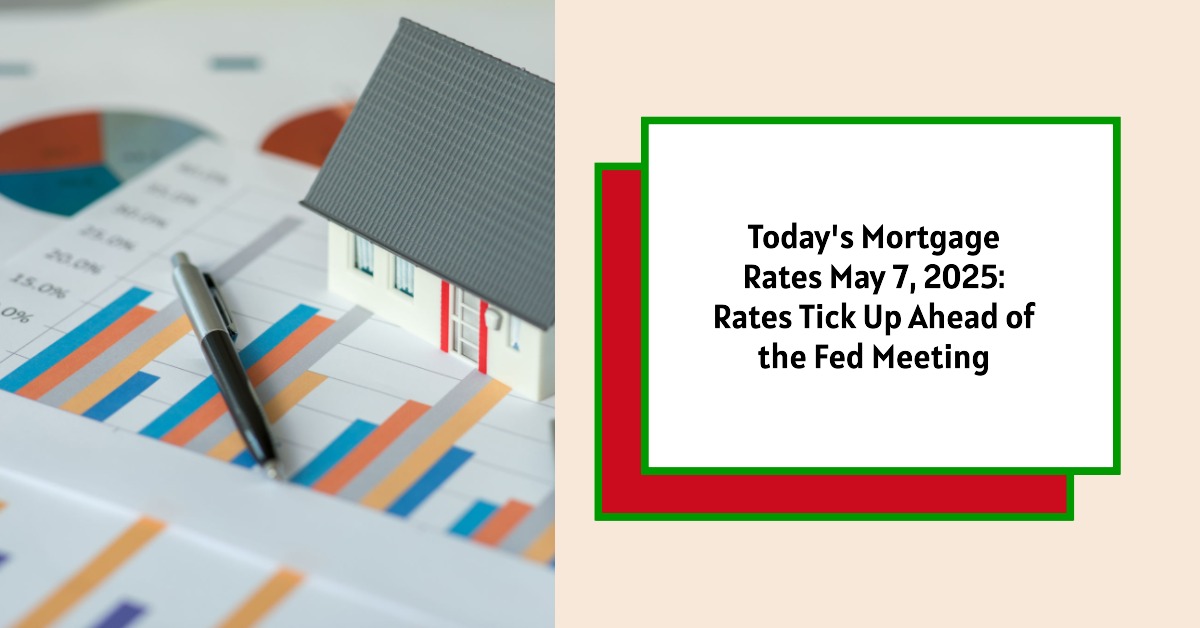As of May 7, 2025, mortgage rates are experiencing an uptick, with a notable rise in both mortgage and refinance rates. The 30-year fixed mortgage rate now stands at 6.79%, a modest increase of four basis points from the previous day. Meanwhile, the 15-year fixed mortgage rate has also risen by four basis points to 6.03%. This rise comes as the markets await an important announcement from the Federal Reserve, which is likely influencing current rates. While expectations lean towards holding the federal funds rate steady, any changes or hints towards future actions may further impact mortgage rates.
Today's Mortgage Rates – May 7, 2025: Rates Tick Up Ahead of the Fed Meeting
Key Takeaways
- Mortgage Rates Increase: The 30-year fixed rate is now 6.79%; 15-year fixed at 6.03%.
- Federal Reserve Meeting: Anticipation of the Fed's announcement may contribute to rate fluctuations.
- Refinance Rates: 30-year refinance rates have reached 6.80%, reflecting similar increases.
- Economic Indicators: Uncertainty surrounding tariffs and inflation expectations continues to sway the market.
- Future Outlook: Potential for rates to decrease if economic conditions weaken significantly.
Understanding Mortgage Rates Today
Mortgage rates are influenced by numerous factors, including economic trends, Federal Reserve policies, and even geopolitical events. On May 7, 2025, rates are generally higher as markets prepare for a significant announcement from the Federal Reserve regarding their monetary policy. Investors and homebuyers are particularly attuned to these developments as they look for signs that might indicate future rate changes.
Today's Mortgage Rates
According to recent data from Zillow, the following are the national averages for mortgage rates updated today:
| Loan Type | Current Rate (%) | Change (Basis Points) |
|---|---|---|
| 30-Year Fixed | 6.79 | +4 |
| 20-Year Fixed | 6.46 | – |
| 15-Year Fixed | 6.03 | +4 |
| 5/1 ARM | 6.96 | – |
| 7/1 ARM | 7.14 | – |
| 30-Year VA | 6.34 | – |
| 15-Year VA | 5.71 | – |
| 5/1 VA | 6.33 | – |
Today's Mortgage Refinance Rates
Refinance rates tend to differ slightly from those of new mortgages due to a variety of factors, including borrower equity and overall lending conditions. Here’s an overview of today’s refinance rates:
| Refinance Type | Current Rate (%) | Change (Basis Points) |
|---|---|---|
| 30-Year Fixed | 6.80 | – |
| 20-Year Fixed | 6.43 | – |
| 15-Year Fixed | 6.07 | – |
| 5/1 ARM | 7.17 | – |
| 7/1 ARM | 7.05 | – |
| 30-Year VA | 6.39 | – |
| 15-Year VA | 5.99 | – |
| 5/1 VA | 6.49 | – |
Deep Dive into Mortgage Types
Understanding different mortgage types can enhance a homebuyer's decision-making process. Let's break down some of the most common mortgage options available today.
30-Year Fixed-Rate Mortgage
The 30-year fixed-rate mortgage is one of the most popular choices among homebuyers. It offers the advantage of lower monthly payments, which can make homeownership more accessible for many. Here are some of its characteristics:
- Predictability: Payments remain constant throughout the life of the loan, making budgeting straightforward.
- Long-Term Commitment: Borrowers enjoy extended terms that allow for more manageable payments; however, they can also face higher total interest payments.
For example, with a $300,000 mortgage at 6.79% for 30 years, your monthly payment would be approximately $1,946. Over the life of the loan, you would pay around $221,000 in interest alone. While this option makes monthly budgeting simpler, potential buyers should be aware of the total interest costs involved in such a long-term loan.
15-Year Fixed-Rate Mortgage
A 15-year fixed-rate mortgage can be appealing for those who want to pay off their home more quickly and save money on interest:
- Lower Interest Rates: Typically, the interest rate is lower than that of a 30-year mortgage.
- Faster Equity Build-Up: Homeowners usually gain equity rapidly, leading to fewer financial obligations over time.
If we take the same $300,000 loan but apply a 6.03% rate for 15 years, the monthly payment would be approximately $2,585. This option means you can pay off your house in half the time, resulting in approximately $61,000 in interest over the life of the loan. Although the monthly payments are higher, it's important to recognize the financial upside in paying off the mortgage more quickly and accruing less interest.
Adjustable-Rate Mortgages (ARMs)
Adjustable-rate mortgages (ARMs) can be a double-edged sword. Here’s how they work:
- Lower Initial Rates: For the first few years (such as a 5/1 ARM), borrowers enjoy lower rates than those fixed-rate mortgages.
- Variable Payments: After the initial period, the rates can change, leading to unpredictable payments.
Currently, a 5/1 ARM with a starting rate of 6.96% could seem attractive for those planning to move within five years. After this fixed-rate period, the rate can adjust based on the market. However, with potential market fluctuations, if rates rise, your monthly payments could increase significantly.
Many homeowners opt for ARMs if they plan to relocate before the initial fixed-rate period ends, potentially saving money without exposure to higher long-term rates.
Factors Influencing Mortgage Rates
Several key factors contribute to the determination of mortgage rates:
- Economic Conditions: Factors like inflation, employment rates, and economic growth significantly impact how rates fluctuate.
- Federal Reserve Policies: Although mortgage rates don’t move exactly with the federal funds rate, they often reflect investor expectations of future monetary policy.
- Market Demand: The demand for mortgage-backed securities can drive rates up or down as investors seek yield in stable loan options.
Read More:
Mortgage Rates Trends as of May 6, 2025
When Will the Soaring Mortgage Rates Finally Go Down in 2025?
The Impact of Fed Rate Decisions on Mortgage Rates
The Federal Reserve’s decisions can create rippling effects on mortgage rates. After several increases in 2022 and 2023 to control inflation, the current outlook is uncertain. Mortgage rates aren’t directly tied to the federal funds rate but often reflect the expectations surrounding it:
- During Rate Increases: Generally, as the Fed increases rates, mortgage rates may rise to reflect higher borrowing costs for banks and lenders.
- Economic Recession: If inflation leads to a downturn, it can create downward pressure on mortgage rates as banks look to entice borrowers.
With the Fed’s next rate announcement happening today at 2 p.m. ET, anticipation surrounds its potential impact on various lending rates. The central bank's communication regarding the economic outlook and its future monetary policy signal may lead to immediate reactions in mortgage markets.
Current Economic Climate and Mortgage Predictions
Mortgage rates are not isolated from broader economic trends. As mentioned, tariffs and geopolitical events have complicated forecasts for 2025 and even beyond. The U.S. economy continues to showcase resilience, illustrated by strong job growth numbers in April, but concerns over inflation and tariffs linger:
- Inflation Pressures: If tariffs cause an inflation spike, the Fed may resort to rate hikes to combat rising prices. This scenario could pressure mortgage rates upwards.
- Economic Indicators: Watching other indicators, such as GDP growth and consumer spending, will provide context for both lenders and borrowers.
Increased inflation expectations have led many analysts to revise their predictions regarding mortgage rates, making them more cautious. If inflation continues to trend above the Fed's target of 2%, the Fed may implement measures that inadvertently lead to higher borrowing costs for consumers.
The Future of Mortgage Rates: A Waiting Game
Given the unpredictability of economic signals, it remains difficult to forecast the trajectory of mortgage rates with certainty. While most major forecasts anticipate that rates may decrease slightly later in the year, this is contingent on several variables, namely:
- Economic Growth: Should the economy show signs of a recession, mortgage rates could decline rapidly to stimulate market activity.
- Domestic and Global Events: Policies, especially regarding trade and tariffs, will likely play substantial roles in influencing borrower sentiment.
For potential homebuyers and homeowners contemplating refinancing, understanding these broader dynamics will be crucial. Staying informed about economic trends will empower borrowers to make decisions aligned with their financial goals and risk tolerances.
Summary:
While the increased mortgage rates on May 7, 2025, reflect current economic sentiments, ongoing developments at the Federal Reserve will be crucial in shaping the future of mortgage and refinance rates. With key economic indicators remaining steady and positive, potential homebuyers and those considering refinancing should stay alert to market conditions and policy announcements. Understanding various mortgage options, their characteristics, and the implications of economic trends is pivotal for making informed financial decisions.
Turnkey Real Estate Investment With Norada
Investing in real estate can help you secure consistent returns with fluctuating mortgage rates.
Despite softer demand, smart investors are locking in properties now while competition is lower and rental returns remain strong.
HOT NEW LISTINGS JUST ADDED!
Speak with an investment counselor (No Obligation):
(800) 611-3060
Also Read:
- Will Mortgage Rates Go Down in 2025: Morgan Stanley's Forecast
- Expect High Mortgage Rates Until 2026: Fannie Mae's 2-Year Forecast
- Mortgage Rate Predictions 2025 from 4 Leading Housing Experts
- Mortgage Rates Forecast for the Next 3 Years: 2025 to 2027
- 30-Year Mortgage Rate Forecast for the Next 5 Years
- 15-Year Mortgage Rate Forecast for the Next 5 Years
- Why Are Mortgage Rates Going Up in 2025: Will Rates Drop?
- Why Are Mortgage Rates So High and Predictions for 2025
- Will Mortgage Rates Ever Be 3% Again in the Future?
- Mortgage Rates Predictions for Next 2 Years
- Mortgage Rate Predictions for Next 5 Years
- Mortgage Rate Predictions: Why 2% and 3% Rates are Out of Reach
- How Lower Mortgage Rates Can Save You Thousands?
- How to Get a Low Mortgage Interest Rate?
- Will Mortgage Rates Ever Be 4% Again?



